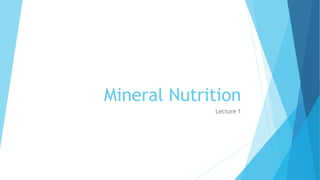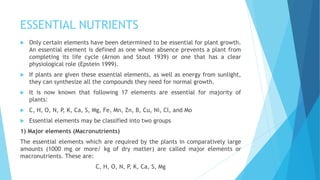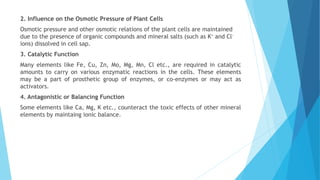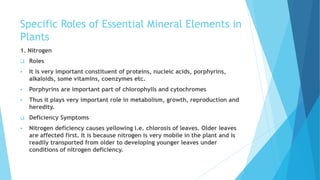Lecture 1.pptx
- 2. Mineral Nutrition ’üĄ The chemical elements are present in minerals which are essential for metabolism, growth, and development of plants constitute mineral nutrients and are obtained by plant roots from the soil in the form of inorganic ions. ’üĄ After being absorbed by the roots, the mineral elements are translocated to the various parts of the plant, where they are utilized in numerous biological functions. ’üĄ Other organisms, such as mycorrhizal fungi and nitrogen-fixing bacteria, often participate with roots in the acquisition of nutrients. ’üĄ The study of how plants obtain and use mineral nutrients is called mineral nutrition. ’üĄ This area of research is central to modern agriculture and environmental protection. High agricultural yields depend strongly on fertilization with mineral nutrients. In fact, yields of most crop plants increase linearly with the amount of fertilizer that they absorb.
- 3. ESSENTIAL NUTRIENTS ’üĄ Only certain elements have been determined to be essential for plant growth. An essential element is defined as one whose absence prevents a plant from completing its life cycle (Arnon and Stout 1939) or one that has a clear physiological role (Epstein 1999). ’üĄ If plants are given these essential elements, as well as energy from sunlight, they can synthesize all the compounds they need for normal growth. ’üĄ It is now known that following 17 elements are essential for majority of plants: ’üĄ C, H, O, N, P, K, Ca, S, Mg, Fe, Mn, Zn, B, Cu, Ni, Cl, and Mo ’üĄ Essential elements may be classified into two groups 1) Major elements (Macronutrients) The essential elements which are required by the plants in comparatively large amounts (1000 mg or more/ kg of dry matter) are called major elements or macronutrients. These are: C, H, O, N, P, K, Ca, S, Mg
- 4. 2) Minor Elements (or Micronutrients or trace elements) The essential elements which are required in very small amounts (less than 100 mg/ kg of dry matter) or traces by plants are called minor elements or micronutrients or trace elements. These are: Fe, Mn, Zn, B, Cu, Ni, Cl and Mo General Functions of Essential Elements in Plants 1. Constituents of Protoplasm and cell walls ’āś C, H, O, N, S and P are very important and permanent constituents of the protoplasm and the cell wall, ’āś C, H, and O form most of the part of plant body. ’āś N is important constituent element of protein and nucleic acid ’āś Mg is an important contituent of chlorophylls while Ca is present in middle lemella in the form of clacium pectate.
- 5. 2. Influence on the Osmotic Pressure of Plant Cells Osmotic pressure and other osmotic relations of the plant cells are maintained due to the presence of organic compounds and mineral salts (such as K+ and Cl- ions) dissolved in cell sap. 3. Catalytic Function Many elements like Fe, Cu, Zn, Mo, Mg, Mn, Cl etc., are required in catalytic amounts to carry on various enzymatic reactions in the cells. These elements may be a part of prosthetic group of enzymes, or co-enzymes or may act as activators. 4. Antagonistic or Balancing Function Some elements like Ca, Mg, K etc., counteract the toxic effects of other mineral elements by maintaing ionic balance.
- 6. Specific Roles of Essential Mineral Elements in Plants 1. Nitrogen ’ü▒ Roles ’é¦ It is very important constituent of proteins, nucleic acids, porphyrins, alkaloids, some vitamins, coenzymes etc. ’é¦ Porphyrins are important part of chlorophylls and cytochromes ’é¦ Thus it plays very important role in metabolism, growth, reproduction and heredity. ’ü▒ Deficiency Symptoms ’é¦ Nitrogen deficiency causes yellowing i.e. chlorosis of leaves. Older leaves are affected first. It is because nitrogen is very mobile in the plant and is readily transported from older to developing younger leaves under conditions of nitrogen deficiency.
- 7. ’é¦ Plant growth is stunted (because protein content, cell division and cell enlargment are decreased). ’é¦ When nitrogen deficiency develops slowly, plants may have markedly slender and often woody stems. This woodiness may be due to a build up of excess carbohydrates that cannot be used in the synthesis of amino acids or other nitrogen compounds. ’é¦ Carbohydrates not used in nitrogen metabolism may also be used in anthocyanin synthesis, leading to accumulation of that pigment. This condition is revealed as a purple or red coloration in leaves, petioles, and stems of some nitrogen-deficient plants, such as tomato and certain varieties of corn.






